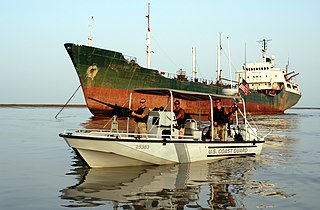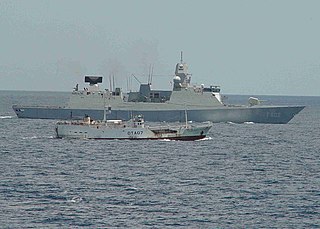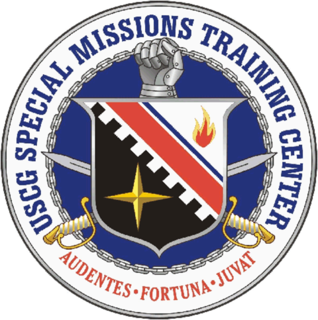
The United States Coast Guard (USCG) is the maritime security, search and rescue, and law enforcement service branch of the United States Armed Forces and one of the country's eight uniformed services. The service is a maritime, military, multi-mission service unique among the United States military branches for having a maritime law enforcement mission with jurisdiction in both domestic and international waters and a federal regulatory agency mission as part of its duties. It is the largest and most powerful coast guard in the world, rivaling the capabilities and size of most navies.

A coast guard or coastguard is a maritime security organization of a particular country. The term embraces wide range of responsibilities in different countries, from being a heavily armed military force with customs and security duties to being a volunteer organization tasked with search and rescue without law enforcement authority. In most countries, a typical coast guard's functions are distinct from those of the navy and the transit police, while in certain countries has similarities to both.

The Eurocopter MH-65 Dolphin is a twin-engined helicopter operated by the United States Coast Guard (USCG) for medevac-capable search and rescue (SAR) and armed Airborne Use of Force missions. It is a variant of the French-built Eurocopter AS365 Dauphin.

Naval Submarine Base Kings Bay is a base of the United States Navy located adjacent to the city of St. Marys in Camden County, Georgia, on the North River in southeastern Georgia, and 38 miles (61 km) from Jacksonville, Florida. The Submarine Base is the U.S. Atlantic Fleet's home port for U.S. Navy Fleet ballistic missile nuclear submarines capable of being armed with Trident missile nuclear weapons. This submarine base covers about 16,000 acres of land, of which 4,000 acres are protected wetlands.

The United States Coast Guard Reserve is the reserve component of the United States Coast Guard. It is organized, trained, administered, and supplied under the direction of the Commandant of the Coast Guard through the Assistant Commandant for Reserve (CG-R).

The 25 ft (8 m) Transportable Port Security Boat (TPSB): is a twin outboard motor, open deck, all weather, high performance, moderately-armed platform capable of operating in inner harbor/near shore environments in light sea conditions. It was first built in FY97 by Boston Whaler in Edgewater, Florida, for the US Coast Guard, Maintenance and Logistic Command. The 25 ft (8 m) TPSB is designed and configured to support Port Security Units as an inshore/harbor surface interdiction response asset in accordance with Required Operational Capabilities (ROC) and Projected Operational Environment (POE) for Coast Guard Port Security Units (PSU), COMDTINST 3501.49 (series). The basic design is based on the standard Boston Whaler 25 ft (8 m) Guardian hull, customized to functionally suit the TPSB mission requirements. The basic craft arrangements consist of a centrally positioned control console and leaning post with an open work deck and low non-obstructive gunwales. The TPSB is outfitted as a military gunboat with three (3) hardened weapon positions: (1) forward .50 caliber (12.7 mm) tri-pod, (2) gunwale - mounted 7.62 mm M240B Machine Gun pipe pedestals, port and starboard.

A Maritime Safety and Security Team, or MSST, is a counter-terrorism team of the United States Coast Guard established to protect local maritime assets. It is also a harbor and inshore patrol and security team that includes detecting and, if necessary, stopping or arresting submerged divers, using the Underwater Port Security System. It is the only special force that can arrest submerged divers.

United States Coast Guard Port Security Units are deployable specialized units organized for sustained force protection operations. They can deploy within 96 hours and establish operations within 24 hours of arrival. PSUs conduct OCONUS port security in support of requesting regional Combatant commander. They provide Anti-Terrorism and Force Protection missions which include harbor and port defense, Humanitarian aid, coastal surveillance, and special missions. PSUs usually operate in U.S. territorial waters under the direction of the Coast Guard's command, but can quickly be called upon the Department of Defense request.

The Defender-class boat, also called Response Boat – Small (RB-S) and Response Boat – Homeland Security (RB-HS), is a standard boat introduced by the United States Coast Guard in 2002. The boats serve a variety of missions, including search and rescue, port security and law enforcement duties and replaces a variety of smaller non-standard boats.
The history of the United States Coast Guard goes back to the United States Revenue Cutter Service, which was founded on 4 August 1790 as part of the Department of the Treasury. The Revenue Cutter Service and the United States Life-Saving Service were merged to become the Coast Guard per 14 U.S.C. § 1 which states: "The Coast Guard as established January 28, 1915, shall be a military service and a branch of the armed forces of the United States at all times." In 1939, the United States Lighthouse Service was merged into the Coast Guard. The Coast Guard itself was moved to the Department of Transportation in 1967, and on 1 March 2003 it became part of the Department of Homeland Security. However, under 14 U.S.C. § 3 as amended by section 211 of the Coast Guard and Maritime Transportation Act of 2006, upon the declaration of war and when Congress so directs in the declaration, or when the President directs, the Coast Guard operates as a service in the Department of the Navy.
The United States Coast Guard is the coastal defense, search and rescue, and maritime law enforcement branch of the United States Armed Forces and is one of the country's eight uniformed services. It carries out three basic roles, which are further subdivided into eleven statutory missions. The three roles are:

Maritime security operations (MSO) are the actions of modern naval forces to "combat sea–based terrorism and other illegal activities, such as hijacking, piracy, and slavery, also known as human trafficking." Ships assigned to such operations may also assist seafaring vessels in distress. These activities are part of an overall category of activities which fall short of open warfare called military operations other than war (MOOTW). MSO also involve the marine environmental protection, creating a safer and clean environment.

The Joint Maritime Training Center (JMTC), also known as the Special Missions Training Center (SMTC), is a joint United States Coast Guard, Navy, and Marine Corps training facility located on Camp Lejeune, North Carolina. JMTC's mission is to provide relevant and credible Maritime Security Training and Operational Testing and Evaluation in support of Department of Defense and Department of Homeland Security missions. JMTC comprises four main divisions: Weapons, Port Security, Engineering / Logistics, and Fast Boat.

Navy Expeditionary Combat Command (NECC) serves as the single functional command to centrally manage current and future readiness, resources, manning, training and equipping of the United States Navy's 21,000 expeditionary forces who are currently serving in every theater of operation. The NECC was established in January 2006. NECC is a subordinate command of the Navy's Fleet Forces Command.
A Sector is a shore-based operational unit of the United States Coast Guard. Each Sector is responsible for the execution of all Coast Guard missions within its Area of Responsibility (AOR), with operational support from Coast Guard Cutters and Air Stations. Subordinate commands within a Sector typically include Stations and Aids-to-Navigation (ATON) Teams. Some Sector commands also have subordinate units such as Sector Field Offices and Marine Safety Units that are responsible for mission execution in parts of the Sector's AOR. There are 37 sectors within the Coast Guard.

The Legend-class cutter, also known as the National Security Cutter (NSC) and Maritime Security Cutter, Large, is the largest active patrol cutter class of the United States Coast Guard. Entering into service in 2008, the Legend-class is the largest of several new cutter designs developed as part of the Integrated Deepwater System Program.

The Deployable Operations Group (DOG) was a United States Coast Guard command that provided properly equipped, trained and organized Deployable Specialized Forces (DSF), which still exist today, to the Coast Guard, United States Department of Homeland Security (DHS), United States Department of Defense (DoD) and inter-agency operational and tactical commanders. Formerly headquartered in Arlington, Virginia, it was established on 20 July 2007, and was commanded by a captain and was decommissioned by the Commandant of the Coast Guard, Admiral Robert Papp on 1 October 2013, although many of the units existed long before the 2007 commissioning. Upon decommissioning, the units previously assigned to the DOG were split between Coast Guard Pacific and Atlantic Area commands.

Patrol Forces Southwest Asia (PATFORSWA) is a United States Coast Guard command based in Manama, Bahrain. PATFORSWA was created in November 2002 as a contingency operation to support the U.S. Navy with patrol boats. The command's mission is to train, equip, deploy and support combat-ready Coast Guard forces conducting operations in support of Operation Iraqi Freedom (OIF), Operation Enduring Freedom (OEF) and Operation Inherent Resolve (OIR) in the Naval Forces Central Command's area of responsibility. It was commissioned as a permanent duty station in June 2004. In July 2003 PATFORSWA moved from its own compound to facilities at Naval Support Activity Bahrain.

The Response boat - Small II, also known as RB-S II, is a small vessel in service in the US Coast Guard. The boats perform a variety of missions such has PWCS, law enforcement, counter narcotics operations, search and rescue, migrant interdiction, and environmental response operations.
















